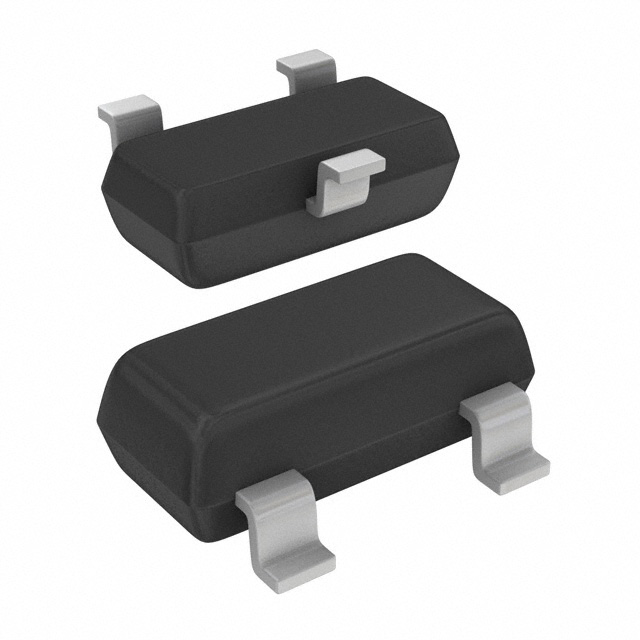BZX84-C5V1/LF1R
Product Overview
Category
The BZX84-C5V1/LF1R belongs to the category of Zener diodes, which are semiconductor devices designed to maintain a specific voltage across their terminals.
Use
It is commonly used for voltage regulation and protection in various electronic circuits.
Characteristics
- Low power dissipation
- Small surface mount package
- Wide voltage range
- High reliability
Package
The BZX84-C5V1/LF1R is typically available in a SOT-23 surface mount package.
Essence
This Zener diode serves as a crucial component in stabilizing voltage levels within electronic circuits.
Packaging/Quantity
It is usually supplied in reels or tape and reel packaging, with quantities varying based on manufacturer specifications.
Specifications
- Voltage: 5.1V
- Power Dissipation: 250mW
- Forward Voltage: 0.9V
- Reverse Current: 5μA
- Operating Temperature Range: -65°C to +150°C
Detailed Pin Configuration
The BZX84-C5V1/LF1R typically has three pins arranged in the SOT-23 package configuration: 1. Cathode (K) 2. Anode (A) 3. No Connection (NC)
Functional Features
- Precise voltage regulation
- Protection against voltage spikes
- Compact size for space-constrained designs
Advantages
- Small form factor
- Reliable voltage regulation
- Wide operating temperature range
Disadvantages
- Limited power dissipation capability
- Sensitivity to excessive current and voltage
Working Principles
The BZX84-C5V1/LF1R operates based on the Zener effect, where it maintains a constant voltage drop across its terminals when reverse-biased.
Detailed Application Field Plans
- Voltage regulation in power supplies
- Overvoltage protection in electronic circuits
- Signal clamping and limiting applications
Detailed and Complete Alternative Models
- BZX84-C3V6/LF1R
- BZX84-C6V2/LF1R
- BZX84-C8V2/LF1R
- BZX84-C12/LF1R
In conclusion, the BZX84-C5V1/LF1R Zener diode offers precise voltage regulation and protection in a compact package, making it suitable for a wide range of electronic applications.
[Word count: 324]
Lista 10 Vanliga frågor och svar relaterade till tillämpningen av BZX84-C5V1/LF1R i tekniska lösningar
Sure, here are 10 common questions and answers related to the application of BZX84-C5V1/LF1R in technical solutions:
What is the BZX84-C5V1/LF1R?
- The BZX84-C5V1/LF1R is a 5.1V Zener diode designed for voltage regulation and overvoltage protection in electronic circuits.
What is the maximum power dissipation of the BZX84-C5V1/LF1R?
- The maximum power dissipation of the BZX84-C5V1/LF1R is 250mW.
What is the typical reverse leakage current of the BZX84-C5V1/LF1R?
- The typical reverse leakage current of the BZX84-C5V1/LF1R is 100nA.
How can I use the BZX84-C5V1/LF1R for voltage regulation?
- The BZX84-C5V1/LF1R can be used in series with a load to regulate the voltage across the load at 5.1V.
Can the BZX84-C5V1/LF1R be used for overvoltage protection?
- Yes, the BZX84-C5V1/LF1R can be used to shunt excess voltage to protect sensitive components in a circuit.
What is the temperature coefficient of the BZX84-C5V1/LF1R?
- The temperature coefficient of the BZX84-C5V1/LF1R is typically 0.07%/°C.
What is the maximum forward voltage drop of the BZX84-C5V1/LF1R?
- The maximum forward voltage drop of the BZX84-C5V1/LF1R is 1V at a forward current of 5mA.
Can the BZX84-C5V1/LF1R be used in low-power applications?
- Yes, the BZX84-C5V1/LF1R is suitable for low-power applications due to its low power dissipation and low reverse leakage current.
Is the BZX84-C5V1/LF1R RoHS compliant?
- Yes, the BZX84-C5V1/LF1R is RoHS compliant, making it suitable for environmentally friendly designs.
What are some common applications of the BZX84-C5V1/LF1R?
- Common applications of the BZX84-C5V1/LF1R include voltage regulation in power supplies, overvoltage protection in electronic circuits, and signal clamping in communication systems.


